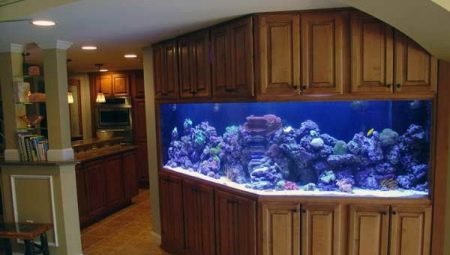The aquarium makes a highlight in any interior, and the angular model is doubly unusual. It contains a large amount of water, but does not take up much space. Such an installation becomes the best decor in the room, mowing the corner, while the narrow space ceases to seem too elongated.
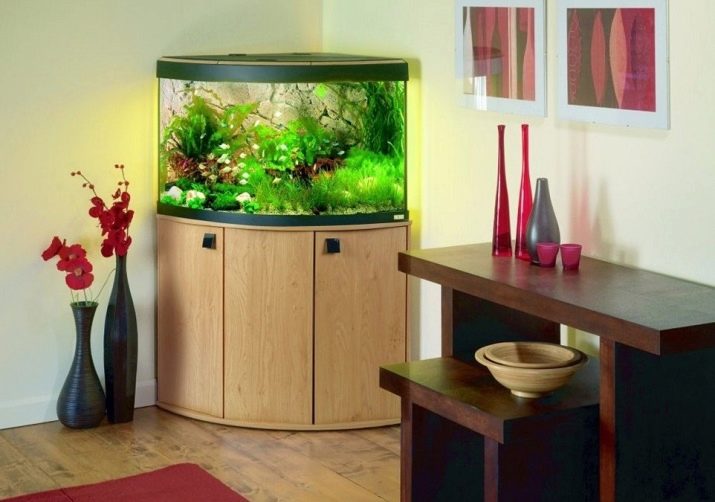
Advantages and disadvantages
The triangular shape for aquariums is not standard, and like everything unusual, it has its supporters and opponents.
This is due to the large number of pluses and minuses related to the extraordinary design.
Let's start with the positive factors.
- An economical and practical arrangement of structures allows you to occupy any empty corner in the room, even one that is limited by a window or doorway, and is not suitable for installing furniture.
- A translucent container in the corner softens the interior line.
- A corner-mounted aquarium is more stable and secure than a stand-alone stand with a small capacity.
- Panoramic glass can emphasize the depth of the water world, which cannot be achieved with a standard rectangular model. The triangular aquarium is quite spectacular even with a small displacement, as the front wall has impressive dimensions.
- The benefits of the aquarium include the ability to keep pets that do not require a lot of attention and care.
- Observation of the inhabitants of the water world relaxes and calms well, in addition, there is a constant humidifier in the room.
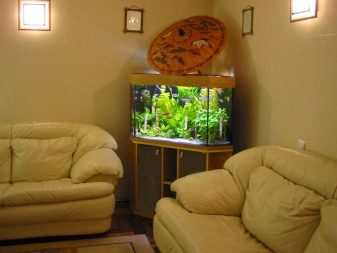
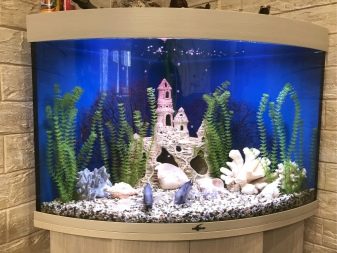
But there are some disadvantages.
- Triangular aquariums are considered non-standard, so the price is higher and the number of models produced is less.
- It is necessary to buy a container together with the cabinet designed for it, since it is difficult to independently select the corner furniture of the required size.
- When designing an aquarium, you should forget about simple design options. In this case, you will have to pay special attention to the far corner.
- Despite the panoramic solution, any non-built aquarium has a better overview, since there is the possibility of a comprehensive inspection.
- Corner aquariums with concave and convex glasses noticeably distort reality, through them the fish seem too small or, conversely, large.
- Aquariums located in the corner receive less natural light than straight-line ones. But many fish do not like the extra light, they need enough beautiful lighting.
- Triangular containers are more difficult to care for, especially to clean the far corner.
- The deepened corner joint is not visible, and in case of leakage, the accident cannot be tracked.
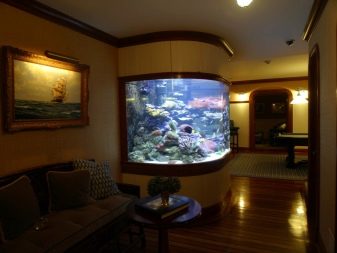
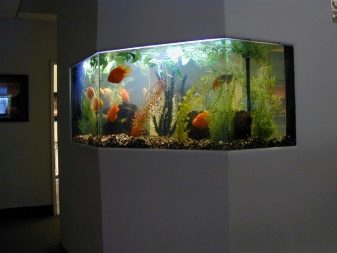
Shape and size options
Triangular aquariums cannot be called classic, but they also have a large selection of volumes.
The smallest of them (up to 40 liters) can be installed on corner tables. For a capacity of 100 or 200 liters, you will need a special cabinet with additional reinforcement.
A high built-in aquarium will require a special design made from durable materials. individually.
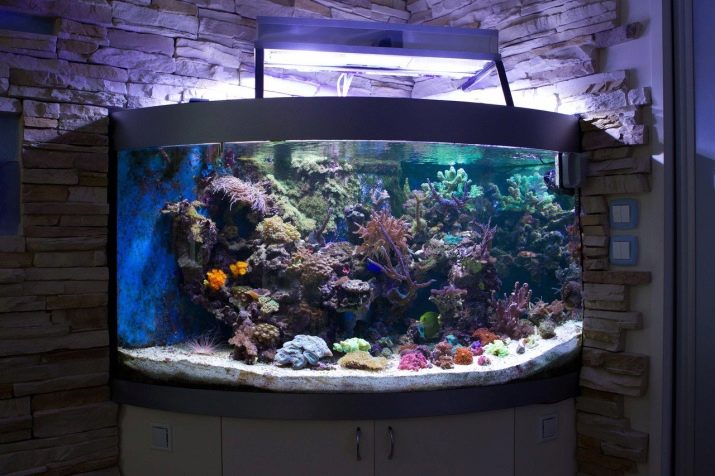
There are several types of corner aquariums:
- L-shaped It is located immediately on two walls, or one part of the container is located against the wall, and the second is deployed towards the room, dividing it into two zones.
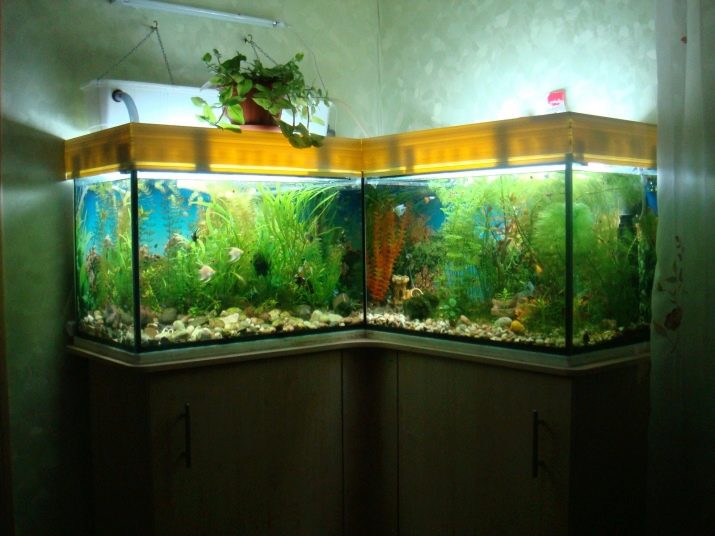
- Triangular pattern becomes a decoration of the corner, it has a good in-depth view.
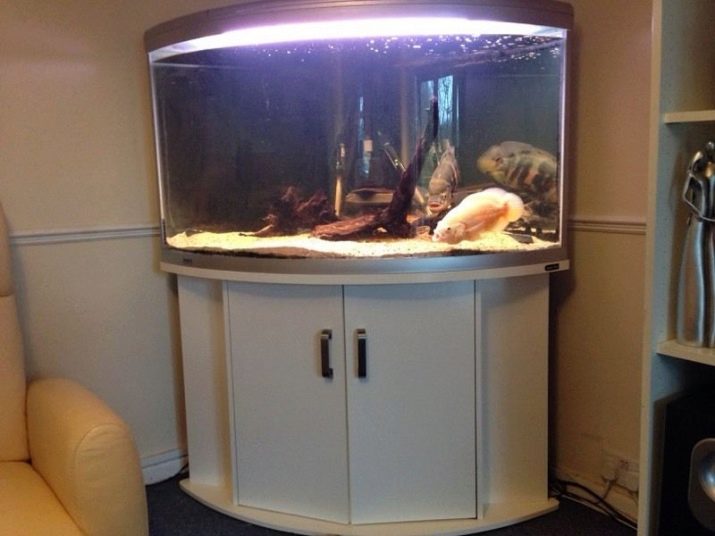
- Panoramic aquarium endowed with concave or convex glass, it simultaneously emphasizes the depth of the structure, and distorts reality.
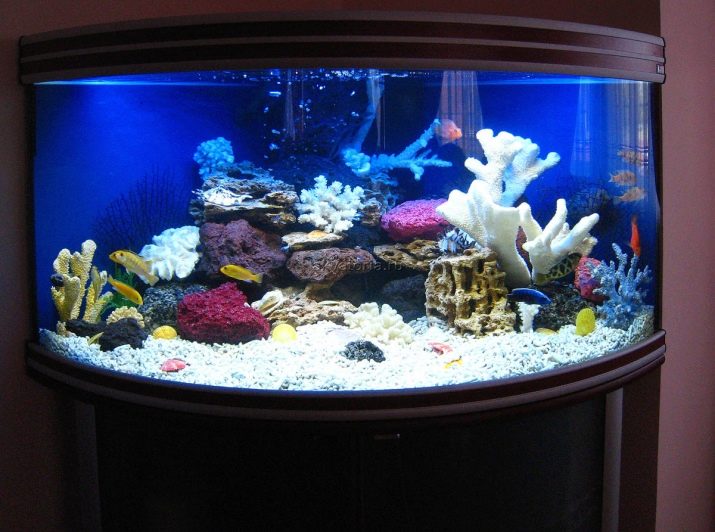
- The front glass of the container can have an arc view or be divided into additional faces (pentagonal version).
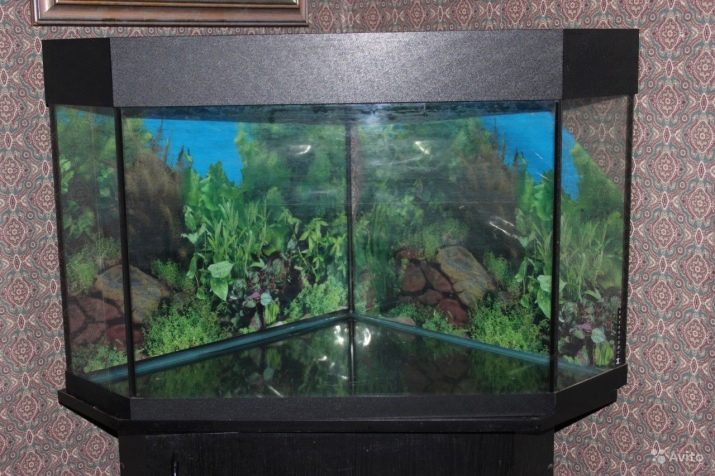
Beginner aquarists often acquire small tanks, believing that they are easier to care for.
In fact, the larger the capacity, the less you have to clean it, and less often change the water.
A small aquarium is not able to create a balanced self-cleaning ecosystem, for this you need a capacity starting from 200 liters. In too high aquariums (more than 60 cm) there is a lack of lighting, which affects the survival of plants.
How to choose?
Before acquiring an aquarium, you should choose a corner for it, look around the surroundings and understand what design, color and volume of the tank will be needed. The aquarium can be ordered according to the catalog, using the services of the Internet or pet stores. Frameless pentahedrons are considered the most popular model for small apartments.
The trihedral design is more fragile, and caring for it will be more difficult. If the angle is insignificant, and the place is limited, you can choose a jar from 50 to 100 liters. In a private house in a large room, it is quite possible to install an aquarium of 700 liters or more.

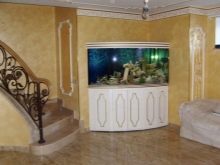
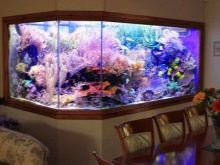
Caring for it is much easier than for a compact model.
It is better to order an angular container right away with a curbstone; it will be difficult to arrange an angle for an aquarium yourself. Accessories are selected taking into account the shape of the can, that is, the corner version will have a triangular cover, special pumps, lighting fixtures.
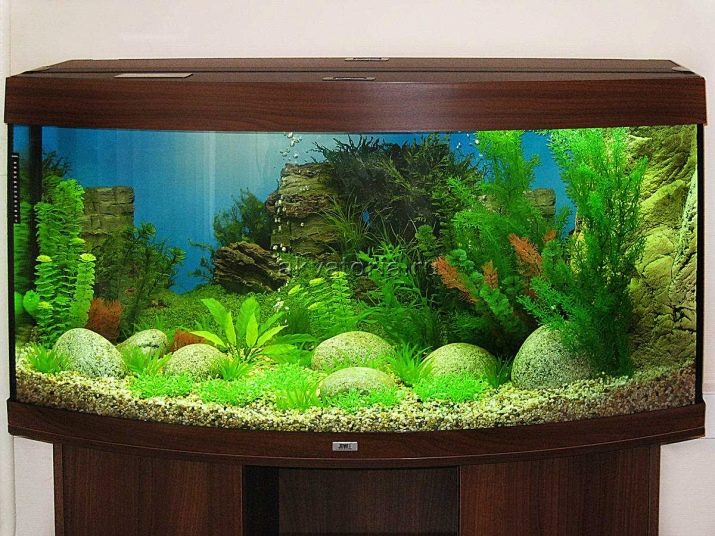
Where to install?
The corner model can be equipped in any room of a private house or apartment, in addition, they are placed in offices, restaurants, schools, kindergartens and other institutions. And although the aquarium is able to profitably occupy an empty, not adapted corner, for its inhabitants not every place in the house is suitable. To correctly install the capacity, you should consider the following nuances:
- To connect the filtration and lighting system, a socket should be near the aquarium;
- Do not place pets in a too noisy place where a TV or music plays;
- it is necessary to avoid the proximity of heating appliances, a refrigerator, a microwave;
- it is better to place the container in the relaxation zone, where you can rest calmly, watching the fish.
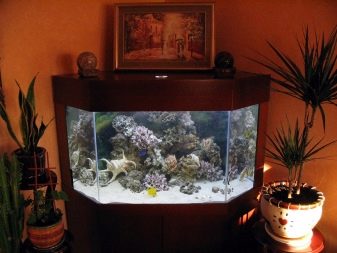

Here are some examples of the successful location of the corner aquarium in the interior:
- the designer designed a passable useless corner with a beautiful built-in panoramic aquarium;
- L-shaped container located immediately at two walls;
- an aquarium is installed between the window and the doorway;
- L-shaped aquarium, made in the form of a curbstone under the countertop;
- unusual design that makes up an obtuse angle.
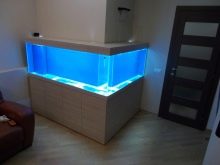
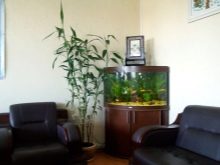
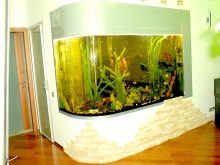
How to equip?
First you need to choose the shape of a corner aquarium: hemispherical (with convex glass), triangular (with a straight front glass or trapezoidal (polyhedron). Each view offers its own viewing options. Large tanks look more impressive. The design of an expensive volumetric aquarium is best entrusted to a specialist. But if you have confidence in your own abilities, you can try to decorate yourself.
Background paintings are selected on the walls of the tank, as if continuing the realities of the underwater world. It can be coral reefs, a landscape of the seabed.
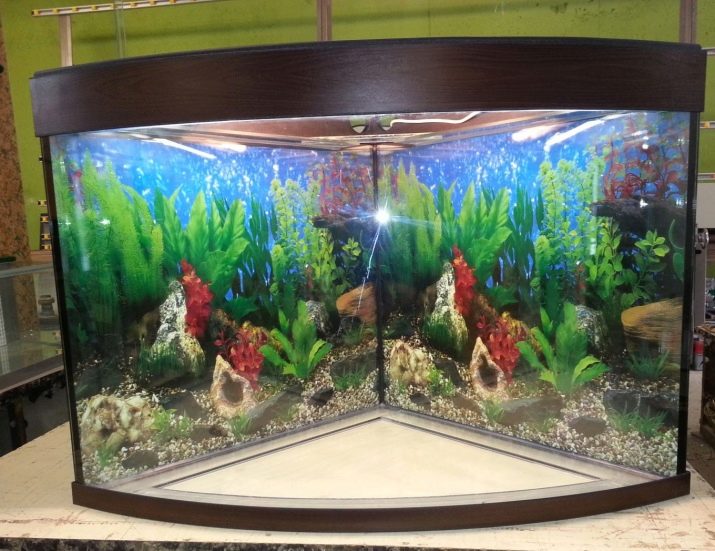
The inside of the aquarium is decorated with shells, corals, plot models of a sunken city or ship. Large figures and large bushes of plants are set in the far corner, as you approach the front glass, the decor should become smaller, and vegetation - less often.
It is important to effectively position the backlight so that the underwater world seems even deeper and more impressive.
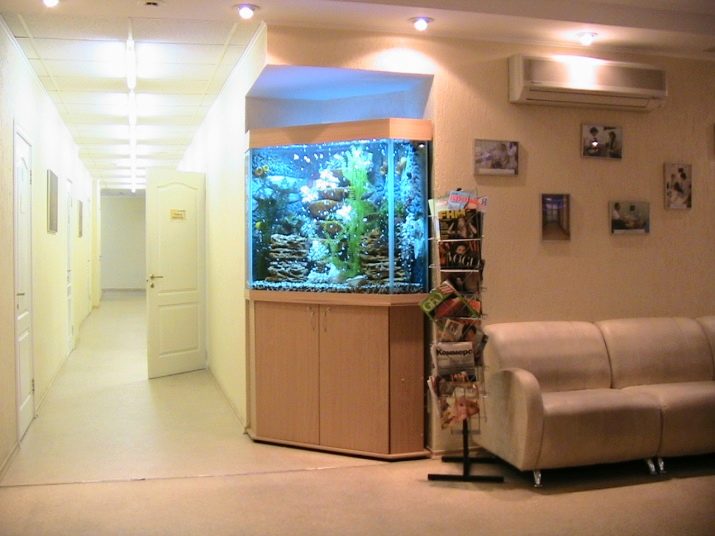
How to contain?
You successfully decorate the aquarium, fill it with water, but this does not mean that it is ready to receive the inhabitants. The environment for fish should “mature”, acquire its bacterial climate. For starters, you can plant plants and 2-5 fish of an unpretentious appearance (guppies, swordsmen) in the aquarium, you will need catfish to care for the bottom. It will take several days, and the fish will prepare the conditions for the rest of the inhabitants of the aquarium.
New inhabitants, before getting into the common reservoir, must live separately for some time, this will make it possible to track unhealthy individuals.
If fish already live in the aquarium, compatible species should be attached to them. Otherwise, larger pets can dine small.
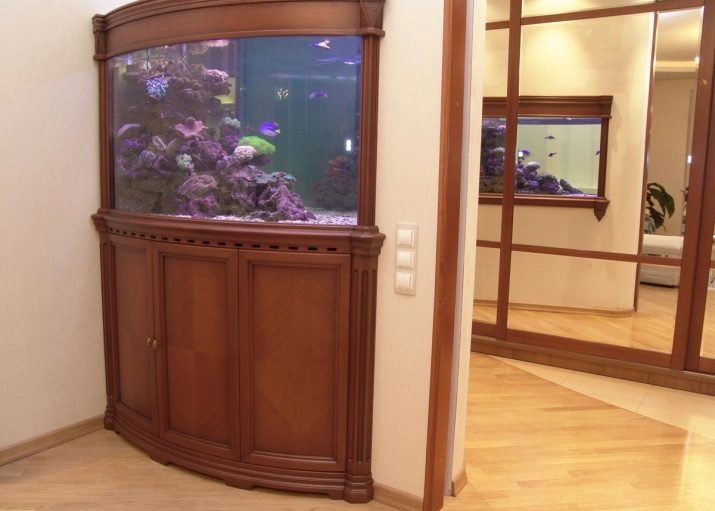
How many and what kind of fish can I keep?
To create optimal conditions for your pets, you need to correctly calculate their amount per liter of water.
The golden rule - 1 cm of the fish’s body per 1 liter of water - is valid only for thin and not too mobile individuals.
The larger and more aggressive the fish, the more capacity will be needed. For example, for one 20 cm discus, a reservoir of 40 liters of water is needed.
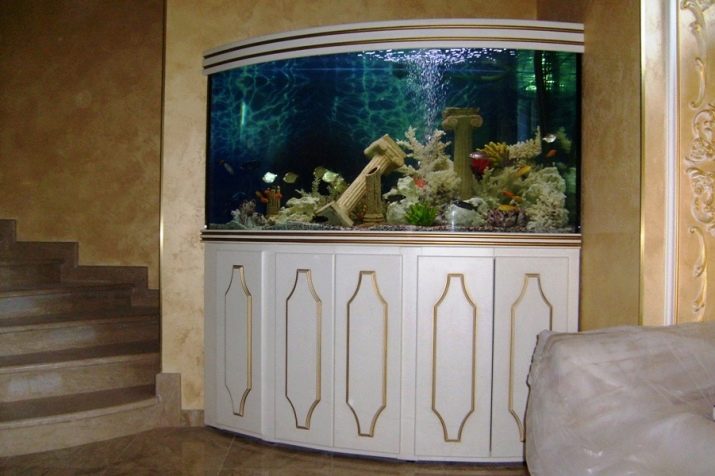
Small fish can live in small aquariums, and even if they are single. Flocking individuals, even small ones, need spacious containers. The larger the area of the aquarium, the more actively oxygen exchange takes place, and the more fish have the opportunity to inhabit it.
Corner models, despite their compactness, can contain impressive volumes of water, they are suitable for different types of indoor fish.
See below for how to care for a corner aquarium.
